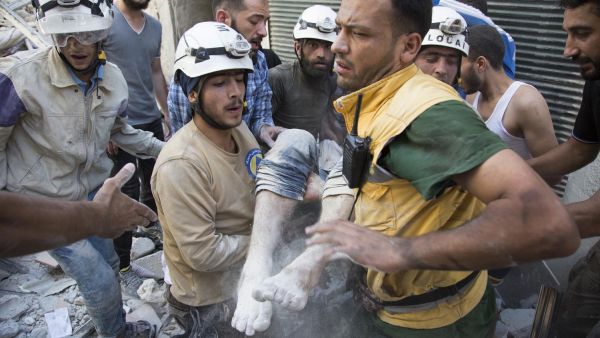- After nearly a decade of violence, understanding the war in Syria has become a daunting task
- State-run propaganda machines are taking advantage of the war's complexity in obfuscating developments or absolving the Assad regime from responsibility
- Bellingcat, an open-source investigative outlet, is seeking to cut through propaganda around Syria
- Their work has outed the use of illegal weapons and looks to work beyond the Middle East
By Ty Joplin
"Journalists assume I've worked in the arms trade," Eliot Higgins, founder of citizen journalist outlet Bellingcat, told a reporter for The Guardian.
"But before the Arab spring I knew no more about weapons that the average Xbox owner. I had no knowledge beyond what I'd learned from Arnold Schwarzenegger and Rambo."
Higgins and Bellingcat is now producing in-depth investigations into conflict zones, weaponry and assessing culpability of heinous attacks; all by using publicly available information.
From the comfort of a home in the middle of England, Higgins first confirmed to the world Syrian regime use of cluster bombs in 2012, banned by international law, in addition to the deployment of barrel bombs and chemical weapons.
Bellingcat has become a crucial resource for policy makers and journalists alike to understand the Syrian, Ukrainian, and Yemeni warzones. Each article comes with an explanation of how the research was conducted and how the journalist came to the conclusion that he or she did. Bellingcat has even made guides on how to mirror their investigation techniques.
Finding Facts in a ‘Post-Truth’ Syria
Civilians receive medical treatment in a makeshift hospital after a chemical weapons attack on rebel-held village of Al Shifuniyah in the Eastern Ghouta, near Damascus (AFP/FILE)
The war in Syria, as dizzingly complex as it can be, is also one of the most thoroughly documented conflicts in history, with torrents of tweets, videos, articles and eyewitness reports after attacks providing mounds of evidence for discerning reporters.
Bellingcat has begun to master the art of information collection in a way few others have, wielding the mounds of documentation to form coherent and falsifiable investigations.
After the most recent gas attack in a suburb of Damascus on April 7, 2018 and the subsequent Western military response against regime targets, observers, journalists and propagandists came out from the bulwark to call into question the veracity of events, defending Syrian President Bashar al-Assad, and denouncing Western military intervention.
Outlets such as Russian state-backed Russia Today and Sputnik News provided platforms for the likes of journalists Eva Bartlett and Vanessa Beeley, and professors Tim Hayward and Piers Robinson to claim the gas attacks were either staged or perpetrated by rebels and that Assad is the rightful, legitimate leader of Syria.
Meanwhile, the independent investigative body set out on a fact-finding mission but legally cannot attribute blame to the attack. France offered an account blaming Assad while Russia disputed the claims.
Cutting through the noise, Higgins and his peers at Bellingcat analyzed thousands of photos, videos, eyewitness testimony and satellite imagery of the sites where the chemical attacks were alleged to have took place.
On April 11, Bellingcat published an investigative analysis which tracked the movements of two Syrian helicopters before and after the chemical attack. They found “two Mi-8 Hip helicopters heading southwest from Dumayr Airbase, in the direction of Douma, 30 minutes before the chemical attack in Douma, and two Hip helicopters were observed above Douma shortly before the attack.”
To put it in context, “the Syrian Government has previously been identified as using Mi-8 Hip helicopters to drop chlorine cylinders on opposition held areas,” the report added.
Bellingcat logo (Bellingcat)
The report then goes into painstaking detail, geo-locating and comparing images of the suspected sites where gas cylinders landed, verifying injuries and deaths to match other casualty estimates and ultimately attributing responsibility to the Syrian regime.
A follow-up analysis piece published on April 29 then goes more in-depth on the gas cylinders themselves, using visual evidence to link them back to previous chemical weapons attacks. They find that cylinders just like the ones found inside Douma have been used before. The report concludes:
“It is clear that the remains of the munitions documented after the April 7th 2018 attack in Douma strongly resemble those documented after aerial chlorine attacks since 2016, showing a clear connection between those previous attacks by the Syrian air force, and the Douma chemical attack. While attempts continue to be made to claim the attacks were faked, the clear resemblance to earlier aerial chlorine attacks strongly indicates the Douma attack was another in a long line of chlorine attacks executed by the Syrian air force.”
Beating Back Propaganda on Syrian Chemical Weapons
Bellingcat has also worked to de-bunk propaganda media narratives claiming the gas attacks were either staged or done by opposition troops.
Immediately after the gas attack, Russian outlets sought to blame the White Helmets for staging the attack. Pro-Assad media outlets have consistently sought to undermine the legitimacy of the White Helmets by saying that they are merely an arm of either Al Qaeda or ISIS.
Russia-1, a state-owned television channel, showed images that supposedly depicted White Helmets setting up the gas attack in a movie studio.
On the set of Revolution Man (Facebook)
On the set of Revolution Man (Facebook)
The images, complete with wardrobes of tattered and blood-stained clothes, were used by Russia-1 to say the gas attack never happened.
Bellingcat however, found the same photos Russia-1 ‘acquired’ as proof of their theory on the public Facebook page of a Syrian Movie called Revolution Man. The photos, published in February 2018, showed actors preparing for scenes for the movie. The men in the photos with white helmets on were indeed actors, but they were acting for an actual movie and not to stage a gas attack.
Shortly after they debunked this myth, Bellingcat set its sights on another, the claim that it was the rebels who released the chlorine gas.
Using the same photos Russian and Syrian-state owned outlets used as ‘proof,’ Bellingcat went to chemical weapons experts to determine if the labs shown could have weaponized chlorine. The answer they received was a resounding ‘no.’
Supposed rebel-held chemical weapons facility (SANA)
Supposed rebel-held chemical weapons facility (SANA)
“All of the equipment, except for the boilers, is at laboratory scale,” which simply isn’t big enough for the scale of the attack witnessed, one expert told Bellingcat.
“But the more fundamental problem is that none of the equipment is what is needed to produce chlorine and compress it into the cylinders that [investigative journalism outlet] Bellingcat has documented.”
Another expert pointed out that filling chlorine gas into containers requires a specialized filling station; something notably absent from the photos shown.
Supposed rebel-held chemical weapons facility (SANA)
In analyzing the dingy and dirty state of the lab, Cheryl Rofer, a retired chemist with experience with chemical weapons said that if this equipment was actually used to weaponize chemicals then “the operators are dead.”
Russian propaganda outlets have sought to obfuscate or explain away events on the ground in Syria. Bellingcat, using publicly available information to debunk them, is having none of it.
Working Within the Fog of War
Because Bellingcat works with mass amounts of tweets, poorly recorded video and the general chaos inside warzones, much of the evidence it collects is unverifiable. Critics of the organization often point this out, while hinting that some of it is either fabricated or manipulated to make Russia or the Syrian regime look bad. Many of these critics happen to be allies of the Russian and Syrian regimes.
And while much of the evidence it collects is unverifiable, it is often later corroborated by similar information collected independently by other governments and organizations. Higgins and Bellingcat just pointed it out first.
In 2012, when the war was first beginning, Higgins was a stay-at-home dad, and made a hobby out of analyzing videos and pictures from Syria. Quickly he noticed continuous reports of the regime using cluster bombs on targets. Cluster bombs, or cluster munitions, are air-dropped bombs that contain many smaller explosives that often create a spread of indiscriminate destruction.
Due to their ability to wreak havoc on concentrations of civilians and infrastructure, they are banned by the 2008 Convention on Cluster Munitions, to which 108 countries are signatories. He quickly published a report detailing his findings under a pseudonym, Brown Moses.
Later, Human Rights Watch conducted its own independent investigation and found the same thing: that Assad has been routinely using cluster bombs against civilians. Amnesty International then did their own study and found the same, documenting Assad’s use of Soviet-made cluster bombs against civilians. The U.S.’ former Secretary of State Rex Tillerson condemned the use of cluster bombs.
But the investigative organization’s work goes far beyond Syria.
It has also geo-located assassins working for drug cartels, tracked American-made missiles used to kill civilians in Yemen, found U.S. and Russian airstrikes hitting targets not previously disclosed and found evidence linking Russia to the infamous downing of Malaysia Airlines Flight 17 over Ukraine that killed nearly 300 people.
“We're aiming to expand into some new regions,” Higgins told Al Bawaba. “So we're currently seeking funding to expand into Latin America, starting with a full time member of staff being based there working with local journalism organisations to train them in open source investigation,then support some of their investigations so they have a real chance to implement it in their own work.”
Additionally, “we're also working on a project that will hopefully bring together a lot of the work being done on Yemen, and make it more accessible.”
Bellingcat has consistently shown that facts matter in a ‘post-truth’ era.
When asked whether we even live in a post-truth era, Higgins told Al Bawaba that we simply don’t, because open-source investigation has just made it easier to root out lies: “We've certainly exposed plenty of lies that way already [using open-source investigation], lies that would have been much harder to check in the past.”







